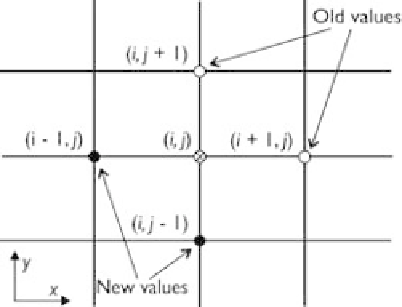Geoscience Reference
In-Depth Information
differential equation:
a
P
φ
=
a
W
φ
+
a
E
φ
+
a
S
φ
+
a
N
φ
+
b
(4.219)
i
,
j
i
−
1,
j
i
+
1,
j
i
,
j
−
1
i
,
j
+
1
φ
(
0
)
to the solution is chosen, the
Jacobi iteration method gives a new approximation by
Assume that
a
P
=
0. If an initial approximation
φ
(
1
)
i
,
j
φ
(
0
)
i
φ
(
0
)
i
φ
(
0
)
i
,
j
φ
(
0
)
i
,
j
=
(
a
W
+
a
E
+
a
S
+
a
N
+
b
)/
a
P
(4.220)
−
1,
j
+
1,
j
−
1
+
1
If the solution is calculated in the order of increasing
i
and
j
, two points (
i
−
1,
j
)
and (
i
,
j
1) have been visited before the solution at point (
i
,
j
) is calculated, as shown
in Fig. 4.26. Therefore, the latest values at these two visited points are not used in
Eq. (4.220) in the current iteration step. For this reason, the Jacobi method is not
efficient. Improvement can be made using the Gauss-Seidel iteration method, which
replaces
−
φ
(
0
)
i
φ
(
0
)
i
,
j
1,
j
and
in Eq. (4.220) by the latest values:
−
−
1
φ
(
1
)
i
,
j
φ
(
1
)
i
φ
(
1
)
i
,
j
φ
(
0
)
i
φ
(
0
)
i
,
j
=
(
a
W
+
a
S
+
a
E
+
a
N
+
b
)/
a
P
(4.221)
−
1,
j
−
1
+
1,
j
+
1
Figure 4.26
Calculation sequence in Jacobi and Gauss-Seidel methods.
4.5.3 ADI iteration method
Alternating Direction Implicit (ADI) iteration method splits or factorizes the 2-D or
3-D algebraic equation in different directions, and then solves the resulting equations
using the TDMA method line by line. The ADI iteration method has many vari-
ants (Hageman and Young, 1981). As an example, a simple 2-D ADI method
is presented here. For the algebraic equation (4.219), the following ADI iteration
method, which has two fractional steps along
i
and
j
lines as shown in Fig. 4.27, is

